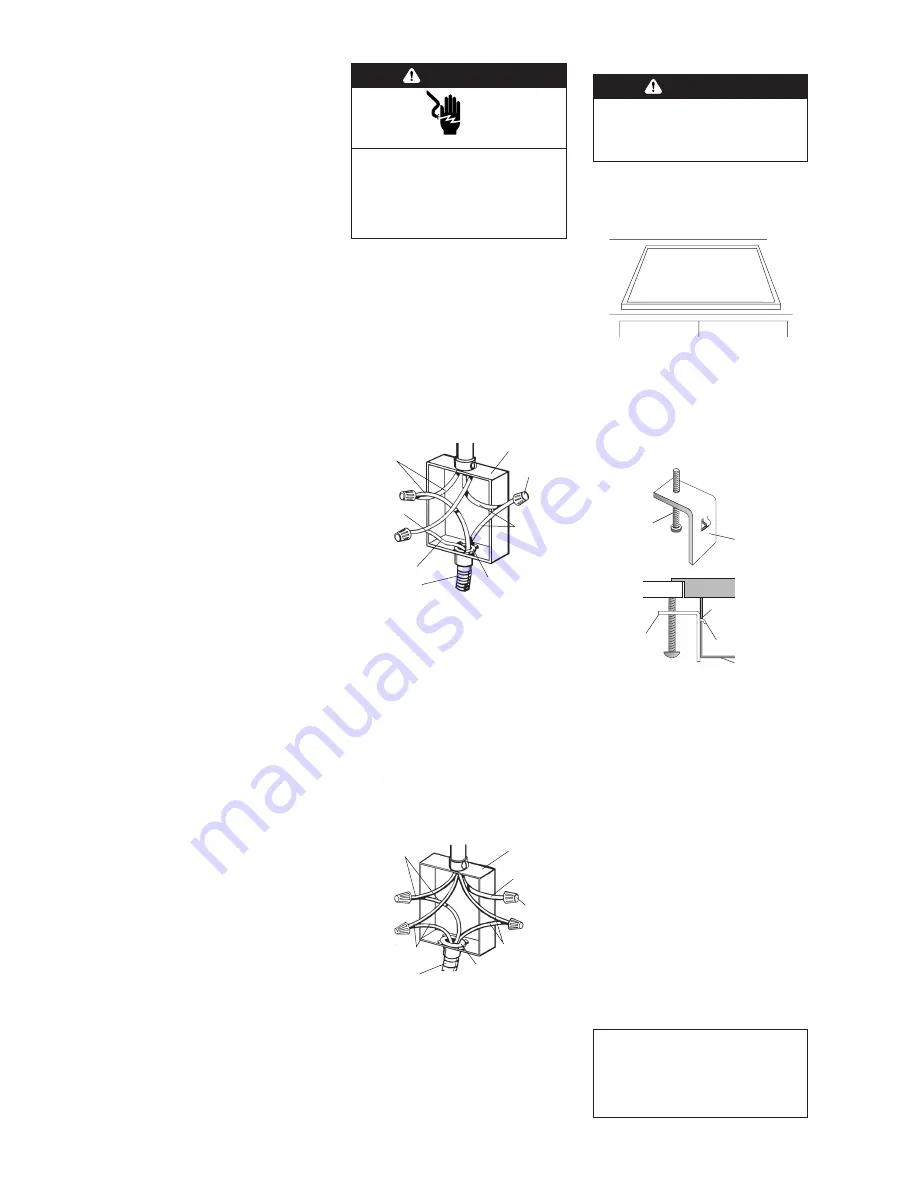
Panel B
Electrical requirements
If codes permit and a separate ground wire is
used, it is recommended that a qualified
electrician determine that the ground path is
adequate.
Do Not ground to a gas pipe.
Check with a qualified electrician if you are
not sure the cooktop is properly grounded.
Do Not have a fuse in the neutral or ground
circuit.
IMPORTANT:
Save Installation Instructions for electrical
inspector’s use.
A.
A three-wire or four-wire, single phase,
240-volt, 60-Hz, AC-only electrical supply is
required on a separate, 40-ampere circuit, fused
on both sides of the line. A time-delay fuse or
circuit breaker is recommended. The fuse size
must not exceed the circuit rating of the
appliance specified on the model/serial rating
plate located on the bottom of the cooktop.
B.
THE COOKTOP MUST BE
CONNECTED WITH COPPER WIRE ONLY.
C.
Wire sizes and connections must conform
to the requirements of the National Electrical
Code ANSI/NFPA 70 – latest edition **, or CSA
Standards C22.1-94, Canadian Electrical Code,
Part 1 and C22.2 No. 0-M91 - latest edition ***
and all local codes and ordinances.
D.
The cooktop should be connected directly
to the fused disconnect or circuit breaker box
through flexible, armored or non-metallic
sheathed, copper cable. The flexible, armored
cable extending from the fuse box or circuit
breaker box should be connected directly to the
junction box.
1. Disconnect power supply.
2. Connect the flexible, armored cable from the
cooktop to the junction box using a U.L.- or
C.S.A.-listed conduit connector. Tighten screws
on conduit connector.
3. Connect the green (or bare) appliance cable
wire with the neutral (white) wire in the
junction box using twist-on connector.
4. Connect the two black wires together; then
connect the two red wires together with twist-
on connector. (See Figure 1.)
B.
Where local codes Do Not permit
connecting the frame-ground conductor to
the neutral (white) junction box wire: (Used
for all Canadian installations).
cable from power supply
junction box
black wires
twist-on
connectors
U.L.- or C.S.A.- listed
conduit connector
cable from cooktop
bare or
green wire
white wire
red wires
1. Disconnect power supply.
2. Connect the flexible, armored cable from the
cooktop to the junction box using a U.L.- or
C.S.A.-listed conduit connector. Tighten screws
on conduit connector.
3. Connect the two black wires together; then
connect the two red wires together using twist-
on connector. (See Figure 2.)
4. Connect the green or bare ground wire from
the appliance cable to the grounded wire in
the junction box or other grounded connector
using twist-on connector.
5. Put a twist-on connector on end of white wire.
junction box
cable from power supply
twist-on
connector
black wires
U.L.- or C.S.A.- listed
conduit connector
cable from cooktop
bare or green
wires
white wire
red wires
Figure 2
Grounded neutral
Figure 1
Ungrounded neutral
Electrical connection
A.
Where local codes permit connecting
the frame-ground conductor to the neutral
(white) junction box wire: (Not used for
Canadian installations).
F.
A U.L.- or C.S.A.-listed conduit connector
must be provided at each end of the power
supply cable (at the cooktop and at the junction
box).
E.
Locate the junction box to allow as much
slack as possible between the junction box and
the cooktop so that the cooktop can be moved if
servicing is ever necessary. Do Not cut the
conduit.
This cooktop must be connected to a
grounded, metallic permanent wiring system
or a ground connector should be connected
to the ground terminal or wire lead on the
cooktop.
This cooktop is manufactured with a frame
connected, green or bare ground wire. Connect
the cooktop cable to the junction box through the
U.L.- or C.S.A.-listed conduit connector.
Complete electrical connection according to local
codes and ordinances.
WARNING
Now start...
With cooktop in kitchen.
2.
Insert the cooktop into the countertop.
Center the cooktop in the cutout. Check that the
front of the cooktop is parallel to the front edge of
the countertop. Check that all required
clearances are met.
If cooktop is not properly positioned, lift the
cooktop off the countertop to make adjustments.
1.
Remove the shipping materials and tape
from the cooktop. Remove the hardware package
from inside the literature bag.
3.
Insert one clamp tab through each slot
located on sides of the burner box.
screw
clamp
cooktop
slot
clamp tab
burner box
Note: If installing cooktop over a built-under oven,
Do Not fasten cooktop to countertop with
clamps. Cooktop will then be easy to remove if
servicing is ever required.
screw and
clamp
assembly
5.
Make electrical connection. (See
“Electrical requirements” and “Electrical
connection” sections, Panel B.)
6.
Turn on power supply.
4.
Secure cooktop to countertop by hand-
tightening each screw; then use a screwdriver to
tighten each screw 1 to 1-1/2 more turns. Do Not
overtighten screws.
7.
Depending on your model, push in and
turn each control knob to the “HI” position or
touch “ON” and turn each control knob to the “HI”
position. Check the operation of the cooktop
elements and indicator lights.
To get the most efficient use from
your new cooktop, read your
Use and Care Guide. Keep
Installation Instructions and Guide
close to cooktop for easy reference.
Copies of the standards listed may be obtained from:
** National Fire Protection Association
Batterymarch Park
Quincy, Massachusetts 02269
*** Canadian Standard Association
178 Rexdale Boulevard
Etobicoke (Toronto), Ontario M9W 1R3
countertop
Electrical Shock Hazard
Turn power supply off before connecting
wires.
Use 8-gauge solid copper wire.
Electrically ground cooktop.
Failure to follow these instructions can
result in death, fire, or electrical shock.
Excessive Weight Hazard
Use two or more people to move and install
cooktop.
Failure to do so can result in back or other
injury.
WARNING

























